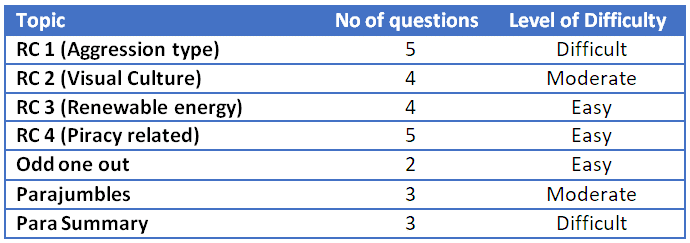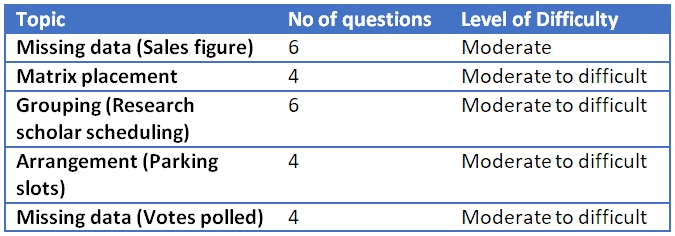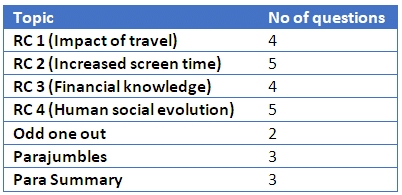Much of CAT 2020 turned out to be as expected, both in terms of pattern and difficulty. Following the announcement of the change in pattern, students were expecting 22-26 questions in each section, and it turned out to be exactly so.
VARC had 26 questions, followed by LRDI, which had 24 questions, with quant coming in end with 26 questions. The topic-wise question distribution across all 3 slots was very much similar to past year papers, with a little change in DILR pattern in which there were two sets having six questions each, and the rest 3 sets having four questions each.
Now coming to the difficulty level, we will have to be a little careful here because different students have shared different experiences. There are many who found the lrdi section manageable, whereas there are some who found the section lengthy and tough.
The level of the sections also varied slotwise. We believe set selection was crucial here.
Quant undoubtedly was the easiest of all sections and came as big sigh of relief. CAT 2020 varc was different from CAT 2019 VARC in one respect: the passages were easy to read and understand. The questions and their options, however, were on the difficult side. Thus varc was a shade easier than last year, but slightly difficult in comparison to the other two sections of the first slot.
CAT 2020 Cutoffs Slot wise:

CAT 2020 slot 1 analysis:
VARC:
Overall difficulty level was above moderate similar to the one in 2019. Comprehension was not very difficult but option choices were close. There were 26 questions overall with the following breakup

Overall a score of around 45 – 48 will be a good attempt and should help you score a percentile of around 99. And a score of around 32-38 should get you a 95 percentile.
LRDI:
This section had a surprise in terms of pattern. There were two sets with 6 questions each and three sets with 4 questions each, overall 24 questions. The level of difficulty was similar to the past years but selecting sets could become confusing as you had to choose between 4 or 6 question sets.
A good idea would have been to stick to topics comfortable for you rather than trying to go for number of questions. The five sets were as follows

A score in the range of 33-37 should help you get a 99 percentile and 95 percentile should be at a score of 27-30.
QUANT
Questions in this section were dominated by Algebra and arithmetic. Difficulty level was close to CAT 2019. Overall breakup of questions was as follows

An attempt of around 12 to 14 questions that is a score of around 35 should help you cross a 95 percentile and a score of 45 should help you get a 99 percentile.
Overall in the Slot 1 paper a score of 120 should help you score a 99 percentile with the 95 percentile being around 100 marks and a score of 85 for a 90 percentile.
CAT 2020 Slot II analysis:
The slot 2 paper was on similar lines as the first slot in terms of pattern, as expected. But the level of difficulty overall was a little higher for the second slot. Section wise the details are as follows
VARC
The section overall was moderate to difficult. The RCs were similar in level of difficulty as the first slot but the TITA questions were more difficult. The number of questions was 26 in this slot as well 18 in RC and 8 in VA. The break up is as follows

Overall a score of around 42-44 will be a good attempt and should help you score a percentile of around 99. And a score of around 30-35 should get you a 95 percentile.
LRDI
The number of questions was same as the first slot. But the level of difficulty was higher. It was important to choose the right sets or one could end up wasting a lot of time. Total 24 questions, with two sets having 6 questions each and three sets having 4 questions each.

A score in the range of 32-35 should help you get a 99 percentile and 95 percentile should be at a score of 25-28.
QUANT
Like the first slot, majority of the questions were from algebra and arithmetic. Level of difficulty was slightly higher than CAT 2019.

An attempt of around 11 questions with good accuracy, that is score of around 30 should help you cross a 95 percentile and a score of 42-44 should help you get a 99 percentile.
Overall in the Slot 2 paper a score of 115 should help you score a 99 percentile with the 95 percentile being around 90 marks and a score of 78 for a 90 percentile.
CAT 2020 slot III Analysis
Slot 3 kept the pattern going from the first two slots. VARC was similar to CAT 2019 level of difficulty, LRDI was on the difficult side as compared to Slot 1 and QA was on the same level as the two earlier slots. The sectional details are as below
VARC
The RCs were readable but the options were close so students had to be careful in choosing questions. VA questions were mixed as the summary questions were easy to moderate whereas the odd one out looked a little on the difficult side.

Overall a score of around 45-48 will be a good attempt and should help you score a percentile of around 99. And a score of around 35-38 should get you a 95 percentile.
LRDI
Sets looked to be of higher difficulty level than the first slot. Students had to be really careful in choosing the sets, as a wrong set choice could lead to a lot of loss in time. Sticking to familiar set types and trying to complete the set would have been a good strategy. Overall attempts were low.

Scores could dip in this session. A score in the range of 28-31 could help you get a 99 percentile and 95 percentile could be at a score of 20-24.
QUANT
Like the first slot, majority of the questions were from algebra and arithmetic. Level of difficulty was similar to CAT 2019.

An attempt of around 11 questions with good accuracy, that is score of around 30 should help you cross a 95 percentile and a score of 42-44 should help you get a 99 percentile.
Overall in the Slot 3 paper a score of 110 should help you score a 99 percentile with the 95 percentile being around 90 marks and a score of 75 for a 90 percentile.


